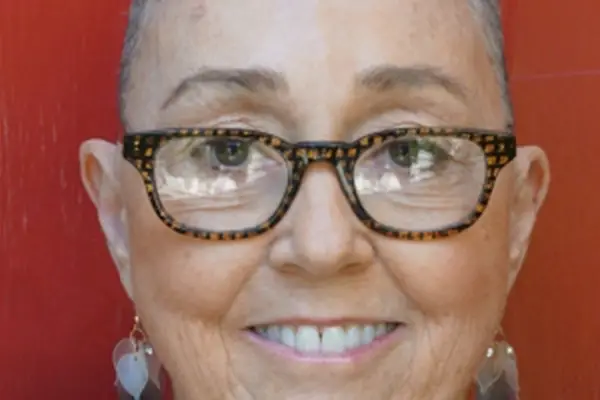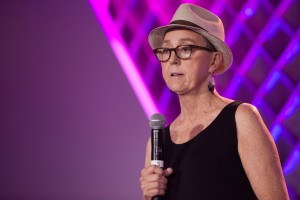
Laurie Becklund, who passed away from a type of breast cancer that is being vastly underreported. PHOTO: Medicinex.Stanford.edu
A former Los Angeles Times staff writer, Laurie Becklund, battled breast cancer since 1996. Earlier in 2015 she knew her time was limited, and as she greeted her last few months, she wrote an opinion piece “As I Lay Dying” about her story. Becklund died Feb. 8 of that year.
This is what she wanted you to know about breast cancer.
Early detection does not cure cancer
Becklund: “I had more than 20 mammograms, and none of them caught my disease. In fact, we now have significant studies showing that routine mammogram screening, which may result in misdiagnoses, unnecessary treatment and radiation overexposure, can harm more people than it helps.”
To detect a cancer early in many cases means to catch it before it produces symptoms. That is a problem, because not every precancerous condition will actually become cancer or not the type of cancer that can affect a person’s life, but every case is treated as if it was the same type of cancer. Mammogram screening is responsible for about 25% of overdiagnosis in breast cancer, according to an article published in Oxford Journals.
The overdiagnosis may harm patients and lead to “overuse of anticancer therapies” such as chemotherapy.
Another article by The New England Journal of Medicine estimated that in 2008, 70,000 U.S. women were overdiagnosed with breast cancer, which is a shocking 31% of all breast cancer diagnoses.
The first time Becklund discovered a lump in her breast in 1996 during a self-exam, she was treated by a lumpectomy and radiation. She had the most “curable” type of breast cancer. Five years after the treatment her doctor told her she had minimal chance of it ever coming back.
Yet in 2009 she received a diagnosis of stage IV breast cancer that spread to her bones, liver, lungs and brain.
Metastatic breast cancer (MBC) is the only kind of breast cancer that kills
Metastatic cancer is “cancer that has spread from the place where it first started to another place in the body,” states Cancer.org. According to a non-profit patient advocacy group Metastatic Breast Cancer Network (MBCN) breast cancer itself does not kill, instead breast cancer patients die from cancer cells travelling to other vital organs.
Breast cancer most commonly spreads to bone, brain, liver and lung. And in Becklund’s case it spread to all four places. When she went to an MBCN conference other attendees were shocked that she was even alive. Almost everyone else had cancer spread to only one organ. When later a group of people she was in was asked to stand if they survived 2 years after diagnosis, most sat down. As far as she could see Becklund was the only one standing for 7 years of survival.
The medical establishment fails their patients
An estimated 40,000 MBC patients die annually. Another 250,000 are waiting for their death.
“I say ‘estimated because no one is required to report a metastatic diagnosis. Death certificates normally report symptoms such as “respiratory failure,” not the actual disease. We are literally uncounted,” Becklund wrote.

Lauire Becklund speaks to an audience. PHOTO: Stanford Medical X/Flickr
While the Surveillance, Epidemiology and End Results (SEER) Program is the main source for cancer statistics, it does not take into account metastatic breast cancer, according to MBCN. It is however estimated up to 30% of all cases are metastatic, and yet they are not counted. Moreover, only 2% of all breast cancer research has been estimated to go towards finding a solution for preventing or treating metastatic breast cancer, according to METAvivor, a non-profit MBC patients’ advocacy organization.
There is no one “cure”
“We are each, in effect, one-person clinical trials. Yet the knowledge generated from those trials will die with us because there is no comprehensive database of metastatic breast cancer patients…” Becklund wrote.
While there is a belief that if a person lives 5 years after the diagnosis they are a cancer survivor, for patients with MBC that means almost nothing. Though there is a treatment, MBC is incurable, according to Fred Hutchinson Cancer Research Center.
Early detection does not help MBC patients either. Another type of breast cancer that was once labeled “cured” by doctors, often comes back years later as stage IV metastatic. And one type of treatment does not work for all MBC patients.
Right now, while new therapies are just starting to emerge, there is still little hope for survival for MBC, and natural and holistic therapies that have shown promise are routinely ignored.
Susan G. Komen’s mission is not helping anyone
“Promise me you’ll never wear a pink ribbon in my name or drop a dollar into a bucket that goes to breast cancer ‘awareness’ for ‘early detection for a cure,’ the mantra of fund-raising juggernaut Susan G. Komen, which has propagated a distorted message about breast cancer and how to ‘cure’ it,” Becklund wrote.
I will be surprised if I find one literate person who is not aware that breast cancer exists and that it is life-threatening for many patients. We are fully aware of that fact. Now what?
Susan G. Komen’s income was $287,409,269 in 2014 and allegedly 79% went into its programs for education, research and support, yet besides being aware, the money spent for over 30 years ($2.6 billion worth) did little for the survival rates of the breast cancer that actually kills – MBC.
“Pink is pretty, but it does not disguise the fact that metastatic breast cancer kills,” reads METAvivor take-action page.
For thousands of women and men who are dying from MBC right now, that is a more believable and honest public-awareness campaign.
This article is for informational purposes only and should not constitute medical advice. Consult a licensed naturopathic doctor for more information.
***
Want to learn more about the most effective ways to prevent and beat cancer? Watch the Truth About Cancer, a 9-part documentary series.
Thanks for installing the Bottom of every post plugin by Corey Salzano. Contact me if you need custom WordPress plugins or website design.













